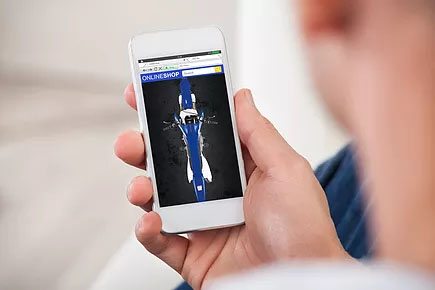Is E-Commerce a Good Choice for Your Dealership?

As I write this it’s Cyber Monday and I’m getting emails from Troy Lee Designs about a 50% OFF sale going on right now for a helmet I recently purchased. Right before my son broke his arm I ordered one of those trick Lit Pro lap time gadgets for us and I haven’t even taken it out of the box. They just emailed me an offer for $100 off <sigh>.
This ecommerce thing is a dicey subject, particularly for brick and mortar retailers. There is no doubt that the Amazon effect is real. According to Forbes magazine 64% of all households are Amazon Prime members. $4 out of every $10 spent online are through Amazon and 80% of online growth is coming from Amazon sales.
I was a slow adopter to Amazon. But, over the last 2 or 3 years, I’ve become addicted (and so has my wife). They’ve just made it too darn convenient. Two nights ago, I was icing my knee with a zip lock freezer bag making a water dripping mess on the couch when I thought about the trick icepacks and straps used by my Physical Therapist. Within about 2 minutes, I’d searched on Amazon and had them on the way. It was so easy to buy, I’d even forgotten I’d ordered them until I get home last night and they’re on the kitchen table. Bam, just like that. That’s why I’ve trained myself to just order it when I need it, because it will arrive before I think about it again and it saves me precious time. But, I’ve trained myself to be a Prime snob because I want free shipping, and most importantly I want it FAST. I’ve noticed that the quick turnaround time usually isn’t there from 3rd party sellers.
And, this is where things get tricky for retailers trying to participate and compete in the online sales game. Amazon has trained the market to expect a seamless, well informed, speedy shopping experience. But, that’s just the beginning of the challenges dealers face when trying to launch an ecommerce division.
Not to poke a hornet’s nest, but many of the brands dealers carry have their own ecommerce sites and sell direct to the consumer. Then there are the 800-pound gorilla ecommerce specialists, like Rocky Mountain ATV/MC, Motosport.com, Motorcycle Superstore, Dennis Kirk, and others which are very difficult to compete with for the typical brick and mortar dealer. These operations usually have everything you see on their site in stock and run more like a logistics company rather than a retailer. In fact, the rumor has always been that Dennis Kirk is owned by distributor Parts Unlimited and of course Motorcycle Superstore is powered by J&P Cycles and owned by the MAG group* which merged with Tucker Rocky back in 2014.
These outfits all have the facilities, budgets, infrastructure, software, etc. to create that well informed speedy shopping experience. On the surface, adding on an ecommerce division to the brick and mortar dealer seems simple enough. Bolt on a shopping cart and offer everything that your OEMs and aftermarket suppliers carry. When the order comes in, if you have it in stock, you pull it and ship it, if you don’t have it in stock you simply order it, then when it arrives ship it to the customer. Easy peasy, right?
Let’s slow down a minute and put on our Parts Manager hat. What percentage of the overall orders that are placed do you think you’d have in stock?
Why would a potential online shopper choose you over the above listed 800-pound gorillas for their mail order needs?
What are the staffing levels, shipping knowledge and supplies needed to handle not only outbound shipping, but also inbound customer returns and exchanges?
How will your DMS integrate with your shopping cart to insure you are showing accurate inventory levels on your web store?
Is your physical inventory dead nuts accurate so you aren’t misleading online shoppers and potential setting yourself up for that awkward, “Sorry, our inventory wasn’t correct” conversation?
These questions and more are some of the pesky details that must be thoroughly thought through before going Ready, Fire, Aim.
In most cases it’s just not realistic on cash flow or inventory turns for a traditional dealer to stock everything for everyone. And unfortunately, many (if not most) online shoppers are looking for selection first and discount second. Driving traffic to a webstore can be expensive as well. I spoke with a dealer at Aim Expo who told me he was spending about $10,000 per month in Google AdWords for his ecommerce site and was doing about $10,000 in sales so he was breaking even. Huh? Heck even if he was making 30% gross profit he still lost seven grand.
But, it can get even worse, because a simple back-ordered or cross-shipped part that causes unexpected delays can upset the customer and they’ll never be back.
I’m not saying ecommerce is a bad choice for all dealers. I know that some dealers have niched themselves by product, category, or geography and had some success. I can see where going narrow and deep may be beneficial for the right dealer with the right skills and knowledge, but going wide and shallow is certainly setting yourself up for failure.
Don’t take your eye of the ball of moving metal, selling F&I, adding P&A, and generating good service work for a bright shiny object or you may find yourself stepping over quarters to pick up nickels.
These are just a few key features of Firestorm. But, unfortunately, I’m out of room and can’t tell you about Firestorm websites, which are an amazing bolt on to all our marketing automation tools. So, call us today at 877-242-4472 to schedule a free demo so we can walk you through how all of these pieces of the puzzle come together.
Thanks for reading, and I look forward to another 100 issues in the future!

